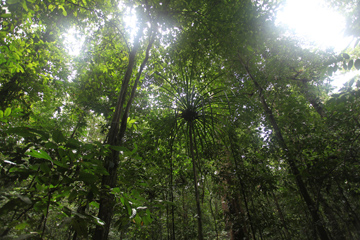The Southeastern Papuan Rain Forests
Location and General Description
This lowland and montane ecoregion is made up of the Owen Stanley Range and surrounding lowland and coastal areas in southeastern PNG. The climate of the ecoregion is tropical wet, which is characteristic of this part of Melanesia, located in the western Pacific Ocean north of Australia (National Geographic Society 1999). The surface geology of the Central Cordillera, of which the Owen Stanleys are an extension, is generally composed of metamorphic and intrusive igneous rocks. More specifically, this ecoregion is composed of metamorphosed Mesozoic greywacke sandstone, siltstone, and marine volcanics overlain by Miocene intrusives, Pliocene marine and terrestrial fine-grained sediments, and Quaternary lavas and pyroclastics (Bleeker 1983).
Most of this ecoregion is composed of tropical wet evergreen forest, with a significant (25 percent) percentage of tropical montane evergreen forest. Smaller percentages of upper montane and freshwater swamp forest are also found (MacKinnon 1997). Coastal vegetation contains Casuarina, whereas mixed coastal vegetation contains Calophyllum, Terminalia, and Anisoptera (MacKinnon 1997).
Lowland forest up to 1,400 m on the north side of the Owen Stanleys is made up of Pometia, Terminalia, Myristica, Horsfieldia, Celtis, and Ficus (MacKinnon 1997). Lowland forest is made up of both alluvial and hill types (Paijmans 1975). Lowland alluvial forest has a canopy that is multitiered and irregular, with many emergents. The forest understory contains a shrub-and-herb layer with a variety of climbers, epiphytes, and ferns (Petocz 1989). Palms may be common in the shrub layer (Paijmans 1975). The somewhat lower-canopy, more closed lowland hill forest contains more open shrub layer but a denser herbaceous layer. Palms are fewer in number. The dominant canopy trees include species of Pometia, Canarium, Anisoptera, Cryptocarya, Terminalia, Syzygium, Ficus, Celtis, Dysoxylum, and Buchanania. Koompassia, Dillenia, Eucalyptopsis, Vatica, and Hopea are locally abundant. Dense stands of Araucaria, the tallest tropical trees in the world, are present in scattered locations (Paijmans 1975; Nightingale 1992).
Although they are subject to variable climates and topography, montane forests are smaller crowned and have more even canopies than lowland hill forest. Tree densities can be high, and the shrub density is also high (Paijmans 1975). Lower montane forest transitioning in from the lowlands is dominated by oaks such as Castanopsis acuminatissima, Lithocarpus, elaeocarps, and laurels. Seventy-meter Araucaria may form thick stands in lower areas. Nothofagus, sometimes in monotypic stands, is conspicuous in the moss-covered mid and upper zones of the ecoregion (Davis et al. 1995).
The Southeastern Papuan Rain Forests

The Southeastern Papuan Rain Forests

The Southeastern Papuan Rain Forests

The Southeastern Papuan Rain Forests
Papua New Guinea (PNG) possesses one of the planet's largest remaining tropical rainforest. At least seventy-five percent of its original forest cover is still standing, occupying vast, biologically rich tracts over 100,000 square miles in all. Its forests provide the habitat for about 200 species of mammals, 20,000 species of plants, 1,500 species of trees and 750 species of birds, half of which are endemic to the island. It has been estimated that between 5 and 7% of the known species in the world live in PNG. Rare plants and animals like the largest orchid, the largest butterfly, the longest lizard, the largest pigeon and the smallest parrot ever registered live in these forests.The forests also constitute the home of the indigenous peoples, the Maisin. For the Maisin, forests provide everything from food and medicinal plants, to materials for houses, canoes and tools. Under the Papua New Guinea constitution, the Maisin are the legal owners of their traditional lands. But these forests and forest peoples are under threat due to large-scale logging activities and oil palm plantations. Oil palm plantations are not aimed at the production of edible oil for the local population and almost the entire production is export-oriented.
ustainable Development and Forest Conservation
Funded by the Chevron Oil company and Greenpeace and agreed by the PNG government after being taken to court by the Maisin people. The PNG government has been under pressure from the World Bank and International Monetary Fund (IMF), and the Australian Government to enforce environmentally-friendly changes in their development programme. Awareness patrols to remote areas by local environmental charity groups have been spreading the message of what exploitative logging will do to rural communities. The recent screening on PNG television station EMTV of the Rainforest Information Centre's documentary Mama Bilong Olgeta on the PNG logging industry was a great success.
The Southeastern Papuan Rain Forests

The Southeastern Papuan Rain Forests

The Southeastern Papuan Rain Forests

No comments:
Post a Comment